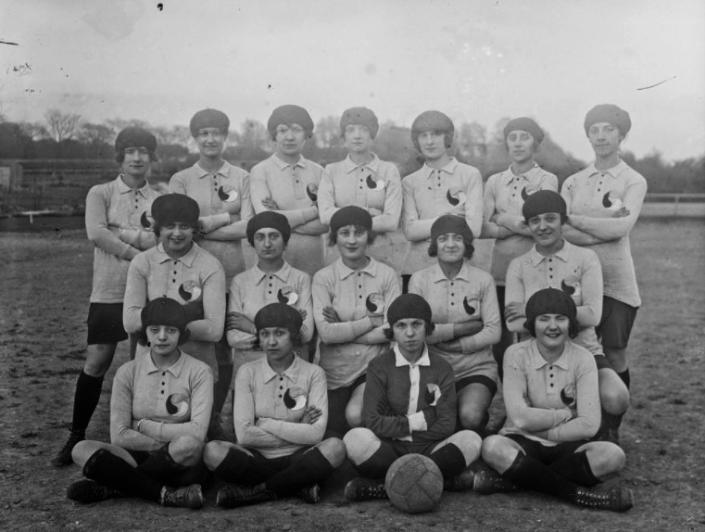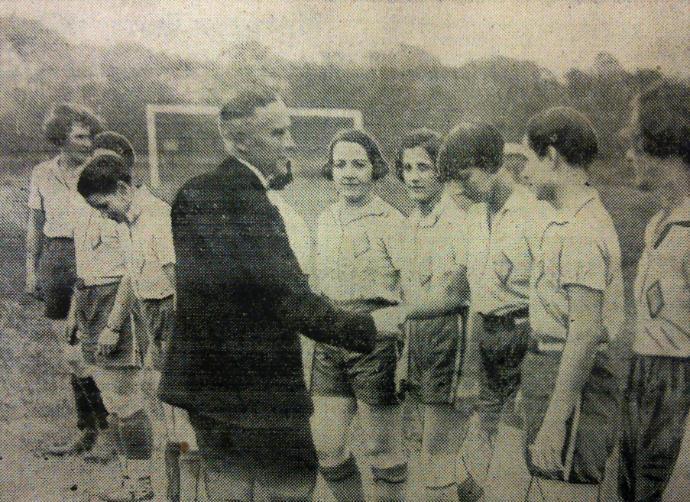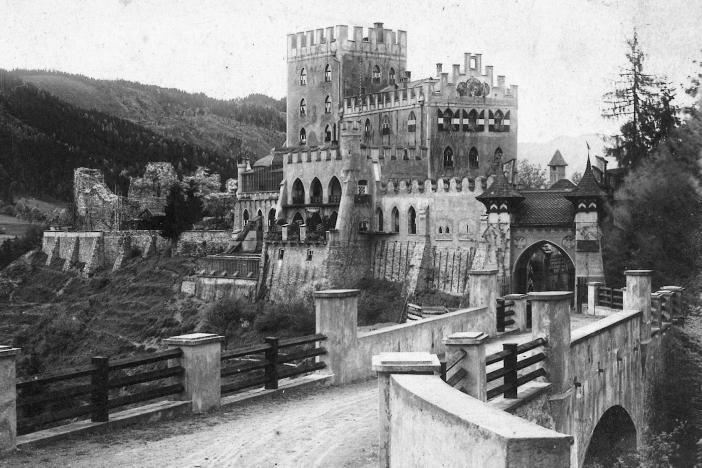Jean Borotra - The Man Who Banned Women's Football in France
07/01/2022 - 5.58
Stuart Gibbs
During the last years of the First World War, women’s football in France steadily made its first tentative steps. Excluded from the main body of sporting activity women formed their own sports organisation and within this new body football for women played a prominent role. By the early 1920s, a vibrant scene involving domestic and even international competition had been established. This, however, came to a complete halt with the establishment of the war-time Vichy government. The Commissioner for Sports, Jean Borotra, over saw sweeping changes in the administration of female sports participation. In England the FA famously banned member clubs hosting or promoting women’s matches. In contrast to the FA, a glorified gentlemen’s club, Borotra’s pronouncement on women’s football was a ban in the true sense of the word. It was also state sponsored.
Women’s Football in France up to the late 1920s
A lack of recognition and support for women by the existing sports organisations led to the formation of a women’s federation, La Fédération des Sociétés Féminines et Sportives de France in January of 1918. During the autumn of 1917, the Paris sports club Fémina played a series of exhibition matches and in 1919, they were involved in a two-legged tie against En Avant to decide the first French championship. From this small beginning French women’s football grew and by 1921, a two-division league had been established. French teams also toured to Portugal and Belgium and a match between France and Belgium held in 1924, should be considered the first true women’s football international. Matches were also held in the UK during the 1920s and 1930s despite the FA ‘ban’. One player that was popular with the crowds during this time was Carmen Pomiés. Born in Paris in 1900, Pomiés played for Fémina in tour matches against Dick Kerr in 1920 and 1921 and later for Dick Kerr themselves. She appeared in a French XI against an England Ladies Football Association (ELFA) sponsored side in 1922 and was part of the Dick Kerr side that travelled to the USA later that year. Carmen Pomiés returned to Paris in the late 1920s, but she remained a popular figure in her adopted homeland.

Femina side from the early 1920s. The team went on to win 11 French league championships. Source: Pascal Leroy
The PSF and Social Developments during the 1930s
By the end of the 1920s, questions were being asked in France over the suitability of football for women. A good deal of this criticism came from health professionals and from a rise in the traditional views of women’s role in society. Pressure on the game also came from the new highly politicised culture that had developed surrounding health and fitness. The right wing PSF party (Parti Social Français) led by François de La Rocque, promoted physical education as a means to improve genes and prepare women for reproduction, ideas, similar in many ways to Mary Bagot Stock’s Women’s League of Health and Beauty in the UK. The perceived harm to women’s reproductive capabilities from sports like football was increasingly seen as undesirable. Against this background, women’s football in France went into decline. A new body, Ligue de Paris, took over the running of the game in 1933, when the FSFSF abandoned football. Fémina won the first championship but by the last edition of the competition the League consisted of only 7 sides. The French select tours continued. In 1936, Carmen Pomiés captained a French XI which travelled to towns such as Blackpool and Bacup as resident opposition for Preston Ladies. A further tour was organised for 1938 but by 1941, the women’s game in France, which had been on a slow decline, came to a grinding halt.

French touring side in Buxton, August 1933. Source: British Newspaper Archive
The Vichy State
Following the outbreak of World War Two, France was occupied with German forces entering Paris on June 14th 1940. The occupation left the country partitioned between the occupied zone to the north and a ‘free’ zone to the south. A new French government was set up in the spa town of Vichy and headed up by Marshal Philippe Pétain and among the positions created on August 7th 1940, was the Commissariat Général à l’Education Générale et Sportive (General Commissioner to General and Sport Education) with Jean Borotra nominated for the position of General Commissioner. Borotra had been a star on the tennis circuit, born in 1898, in Biarritz a coastal town on the Bay of Biscay. He became involved with tennis just as the game was moving from country club roots to a mass appeal sport with the charismatic Borotra helping to generate a new audience. During the 1920s and 1930s, Borotra, along with Jacques Brugnon, Henri Cochet and René Lacoste were part of the group of French players known as the ‘Four Musketeers’ He was an Olympic bronze medallist in 1924, won the Australian and French Opens and was two times Wimbledon Champion in 1924 and 1926. With his career on the tennis court and his association with the PSF, Borotra seemed like the ideal choice for commissioner.

Jean Borotra as Sports Commissioner in Tous les Sports, 10th January 1942. Source: Wiki Commons
As Vichy’s Sports Commissioner Borotra pushed forward many of the ideas developed by the PSF and associated groups such as introducing a mandatory nine hours per week of physical education for primary and secondary school pupils. He oversaw the banning of professionalism in both tennis and wrestling; with a 3-year delay for association football. Rugby League was prohibited as was Barette a regional code of rugby which was popular with women in the years following World War One. Another motion which ‘vigorously prohibits’ women playing association football was also passed by the committee. On March 27th 1941, a full list of sports prohibited to women was published. Carmen Pomiés was still living in Paris at the time of the occupation and together with some of the players from the 1930s tours to England attempted to keep the game alive despite Borotra’s ban. At the Paris Sports Club Cercle Athletique de Montrouge, in a section close to, of all things tennis courts, ad-hoc football matches were played. Commenting on breaking the General Commissioner of Sports decree on women’s football, Pomiés noted: ‘They would have thrown us in gaol if they had caught us’. As it turned out however, it was Jean Borotra who ended up being arrested.
Arrest, Internship and the Battle of Itter
By April 1942, Borotra had fallen from favour and was replaced as Commissioner by Joseph Pascot. Borotra was later arrested and deported to Germany for ‘patriotic fervour’ and interned at the Sachsenhausen concentration camp before being moved to Itter Castle in Austria. Built in 1870, the castle was officially leased the Reich Government in 1940 and was converted for use as a holding camp for prominent French detainees. At Itter, Jean Borotra was reunited with former members of the Vichy government as well as former President Albert Leburn, Prime Minister Paul Reynolds, Marie-Agnès Cailliau sister of Charles DeGauille and PSF leader François de La Rocque. For the next two years, Borotra remained in this tense politically diverse environment and as the war drew to a close, conditions at the castle deteriorated with food becoming scarce. Various SS officials stopped at Itter as they attempted to escape the advancing Allies. This included the notorious commandant of Dachau, Eduard Weiter who stayed for three days before shooting himself on May 3rd.

Itter Castle where Jean Borotra was held from 1943 to 1945. Source: Wiki Commons
The following day, Itter’s Commandant Wimmer abandoned the Castle as did the guards, deserted the inmates decided to try and contact the Allies. Zvonimir Čučković a former inmate of Dachau who worked at the castle as an engineer, volunteered to go to nearby Wörgl in a bid to get help. At Wogal however, he encountered a Wehrmacht unit commanded by Major Josef Gangl on their way to Kufstein with the intention of surrendering. and was directed towards Innsbruck where American units had just moved in. Making his way to Innsbruck Čučković came across the US 103 Infantry Division and after a discussion with Major John Kramers a small task force had been put together to rescue the inmates at Itter. Within two hours they had set off but several miles short of Wörg, Major Kramers column was held up by enemy shell fire. Major Gangel, meanwhile, had reached Kufstein under a white flag and when he related the plight of the French VIP prisoners to the 23rd Tank Battalion command another task force was raised commanded by Lieutenant Jack Lee. Included in the force were, bizarrely, Major Gangel and 20 soldiers of the Wehrmacht.
The force arrived at Itter in the late evening of May 4th, and consolidated their position. At 4:00am on May 5th, Itter Castle came under fire from elements of the 17th Waffen-SS Grenadier Division. By the afternoon of May 5th, the American-German force was all but out of ammunition and during a lull in the fighting Lee agreed to Jean Borotra’s offer to try and get help. In a lull in the fighting Borotra slipped out of the Castle and made a forty-yard dash across open ground to the nearby woods evading SS troops. Borotra was known for his suave turnout on the tennis tour but he left Itter dressed as a peasant and was met with surprise when he encountered troops from the 142nd Division which had left Wörg two hours earlier. He was able to give the force an appraisal of the situation at Itter. When the column finally arrived at the castle at around 4:00pm they quickly mopped up the SS division. Jean Borotra made it back to Paris but he was kept under house arrest while charges were being considered for his collaboration with Vichy. In the end the charges were dropped and he finally tasted freedom at the end of May 1945.
Life during the Immediate Post War
On October 4th 1945, the afternoon London to Glasgow train drew into Preston station, and stepping out onto the platform was Carmen Pomiés. She had returned under the auspices of the new Ministry of Sport and Education and there to greet her were Alfred Frankland and Margaret Thornborough, old associates from her Dick Kerr days. Officially, the visit was to revive international hockey events but football was also discussed and the following year a French select side toured with Preston Ladies. The visit of the French side became an annual event through the rest of the 1940s and early 1950s. However, it took until the mid 1960s before women’s football in France reached anything like its pre-war level. In 1946, Carmen Pomiés immigrated to the USA settling in Rochester where she worked as a secretary at the Teale Machine Company. She also pursued, of all thing’s tennis, and was the Rochester Club champion in 1947. Pomiés was one of the top seeds for the 1948 Genesse Valley Club Invitational and she regained her Rochester title in 1950. Later that year Carmen Pomiés left Rochester to take up a position as interpreter at the newly opened UN building in New York.
After Jean Borotra’s release from house arrest he returned to the tennis circuit but his association with Vichy tainted his reputation. As a result, he encountered some difficulty in the immediate post-war period, for instance he was for a time, barred from travelling to Britain for the Wimbledon Championships. In an attempt to improve his image Borotra’s role at Itter was played up and the award of the Médaille des évadés (Medal of Escapees) helped in his rehabilitation. By June 1947, Jean Borotra was part of the French Davis Cup team for a Europe area semi-final match against Czechoslovakia, the tie however proved disastrous and his post-war career never lived up to his pre-war exploits. Indeed, the only honour he could point to in those later years came as a result of that war-time dash across an Austrian field.
Biography
Stuart Gibbs is a graduate of Glasgow School of Art, Stuart has participated in exhibitions focusing on women’s football history, these included Moving the Goalposts, First Ladies of Football and a Game for Girls. He has written articles on subjects such as Art, Theatre, and Sports History for Mainly Museums, Discover Magazine, and Playing Pasts. Stuart is also a volunteer researcher with Kent University and was part of the Great War Theatre, Mapping Irish Football and Miracle Workers research projects. He has contributed to MG Alba’s Honeyballers and Rose Reilly documentaries, and the Futures Theatre Production Offside and was involved with women’s football as part of the back-room staff at Glasgow City FC and Queens Park WFC until 2019.



/prod01/wlvacuk/media/departments/digital-content-and-communications/images-2024/Diane-Spencer-(Teaser-image).jpg)
/prod01/wlvacuk/media/departments/digital-content-and-communications/images-18-19/220325-Engineers_teach_thumbail.jpg)
/prod01/wlvacuk/media/departments/digital-content-and-communications/images-2024/240509-Menopause-Research-Resized.jpg)
/prod01/wlvacuk/media/departments/digital-content-and-communications/images/Maria-Serria-(teaser-image).jpg)
/prod01/wlvacuk/media/departments/digital-content-and-communications/images-2024/241014-Cyber4ME-Project-Resized.jpg)
/prod01/wlvacuk/media/departments/digital-content-and-communications/images-2024/240315-Research-Resized.jpg)
/prod01/wlvacuk/media/departments/digital-content-and-communications/images-2024/BDA-group-photo.jpg)